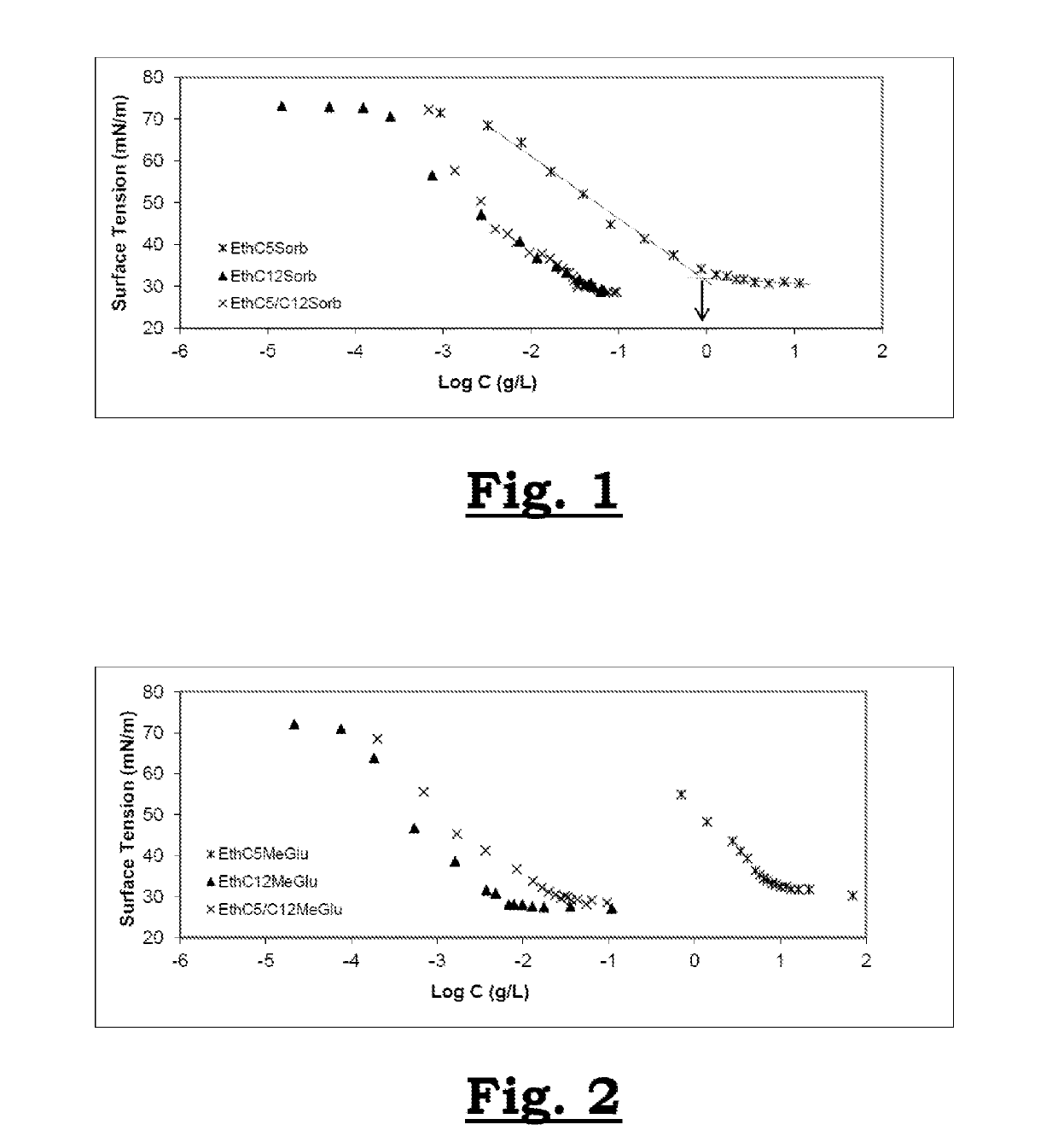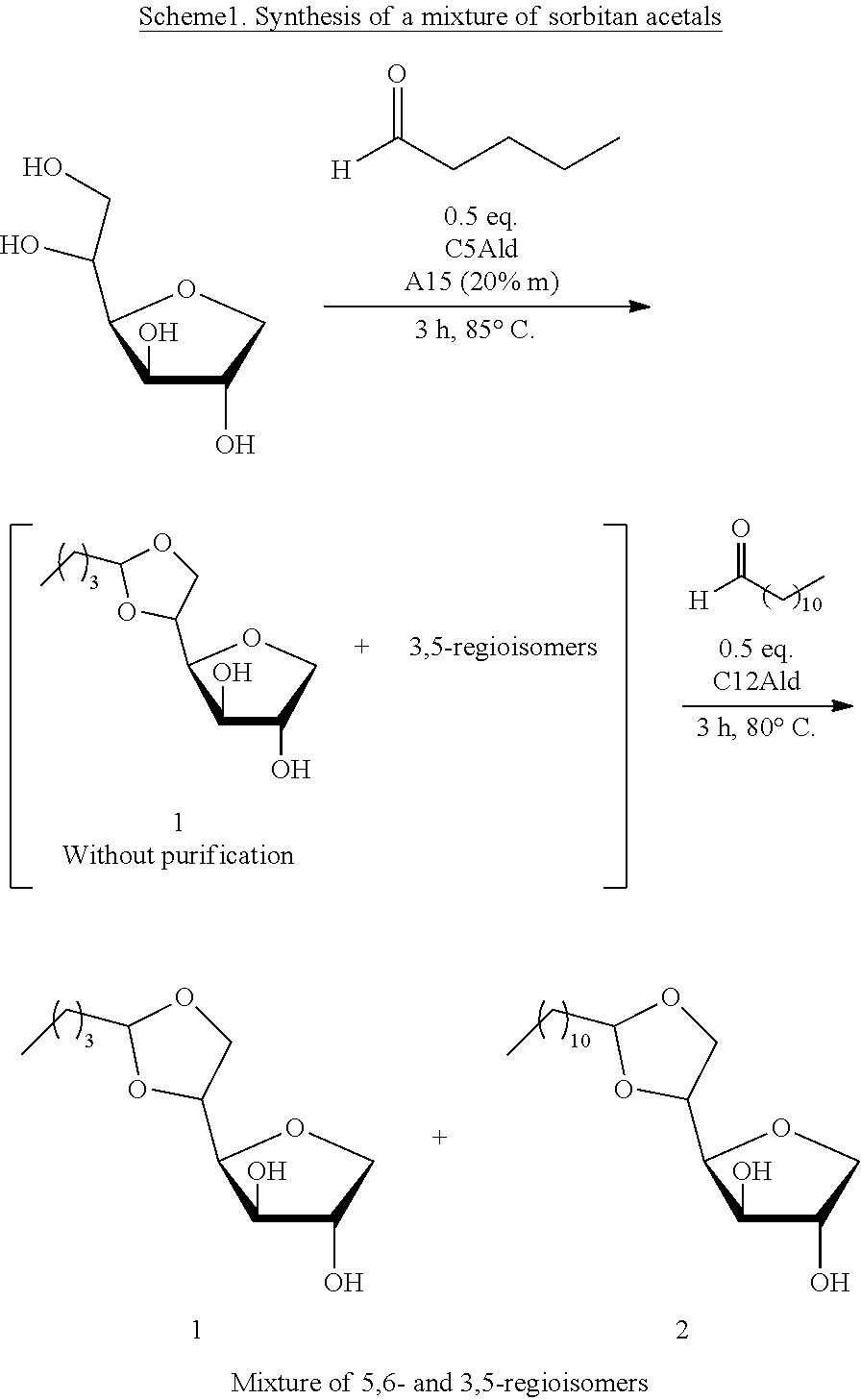Synthesis of monoethers of sugar comprising a long alkyl chain and uses thereof as a surfactant
a technology of alkyl chain and monoether, which is applied in the direction of sugar derivates, organic chemistry, transportation and packaging, etc., can solve the problems of inconvenient process, high cost and/or toxic solvents, and inability to prepare derivatives of ethers based on carbohydrates
- Summary
- Abstract
- Description
- Claims
- Application Information
AI Technical Summary
Benefits of technology
Problems solved by technology
Method used
Image
Examples
example 1
and Methods
[0090]General Procedure for Measurements of Surface Tension
[0091]Surface tension was measured at (25.0±0.1)° C. with a Krüss K100MK2 tensiometer using a platinum rod as probe. A total of 1.0 ml of water was added to the measuring vessel. When the surface tension is stable (standard deviation of the last five measurements of 0.2 mN / m), manual dilution is carried out with a concentrated solution of surfactant to its limit of solubility while maintaining constant volume.
[0092]Analytical Methods
[0093]All the reactants and solvents used for the synthesis are commercial products (supplied by SIGMA-ALDRICH and ACROS ORGANICS), which were used without further purification. All the new compounds obtained were characterized by spectroscopic data. The reactions were monitored by thin-layer chromatography using silica gel on aluminum plates (60F254). The nuclear magnetic resonance (NMR) measurements were recorded on a Bruker DRX 300 or 400 or Bruker ALS 300 spectrometer. The chemical...
example 2
of the Sorbitan Acetals
[0096]Firstly, the sugar acetals were prepared by acetalization or trans-acetalization of sugars following the procedure described in patent application FR 3 007 031. The ratio of 2:1 between the sugar and the aldehyde was not changed but 0.5 equivalent of a long-chain alkyl aldehyde or of its acetal was replaced with 0.5 equivalent of a short-chain alkyl aldehyde or of its acetal to aid dissolution of the reactants (scheme 1). The desired products were obtained in the form of a mixture of short-chain and long-chain acetals with improved yields for long-chain alkyl acetals, relative to the conventional procedure.
[0097]
[0098]In order to synthesize the acetal of sorbitan dodecylidene with a better yield, sorbitan was reacted with valeric aldehyde (0.5 equivalent) in the presence of 20 wt % of AMBERLYST® 15 (A15) as acid catalyst. The reaction may be carried out using anhydrous tetrahydrofuran (1 M) or cyclopentyl methyl ether (1 M) as solvent or in conditions wi...
example 3
Hydrogenolysis of the C5 / C12 Acetals
[0102]Hydrogenolysis of the mixture of sorbitan acetals of 3,5- and 5,6-pentylidene (1) and of dodecylidene (2) was carried out using the conditions already described by the inventors in a previous French patent application No. 14 / 01346. The optimized hydrogenolysis conditions [5 mol % of Pd / C (5%), 120° C., 30 bar of H2, CPME (0.1 M), with a mechanical stirring speed of 800 rev / min] were used for the synthesis of sorbitan monoethers in position 3, 5 and 6 obtained from sugar acetals (scheme 2).
[0103]
[0104]
TABLE 2Hydrogenolysis of sorbitan acetalsa:SugarConversionIsolatedRatioSelectivity Entryacetal(1 + 2)b(%)yield (3 + 4)dC5:C12cYield 4(%)1C1297——55d572*C5 / 12651836:6417e263C5 / C12>988948:5268e69aExperimental conditions: sorbitan (20 mmol), Pd / C (5 mol %, 5% Pd), 120° C., 30 bar H2, stirring speed = 800 rpm*magnetic stirring, 15 h.bConversions determined from the 1H NMR spectra.dIsolated yield.eYields calculated with the C5 / 12 ratio.
[0105]The resul...
PUM
| Property | Measurement | Unit |
|---|---|---|
| pressure | aaaaa | aaaaa |
| pressure | aaaaa | aaaaa |
| temperature | aaaaa | aaaaa |
Abstract
Description
Claims
Application Information
 Login to View More
Login to View More - R&D
- Intellectual Property
- Life Sciences
- Materials
- Tech Scout
- Unparalleled Data Quality
- Higher Quality Content
- 60% Fewer Hallucinations
Browse by: Latest US Patents, China's latest patents, Technical Efficacy Thesaurus, Application Domain, Technology Topic, Popular Technical Reports.
© 2025 PatSnap. All rights reserved.Legal|Privacy policy|Modern Slavery Act Transparency Statement|Sitemap|About US| Contact US: help@patsnap.com



